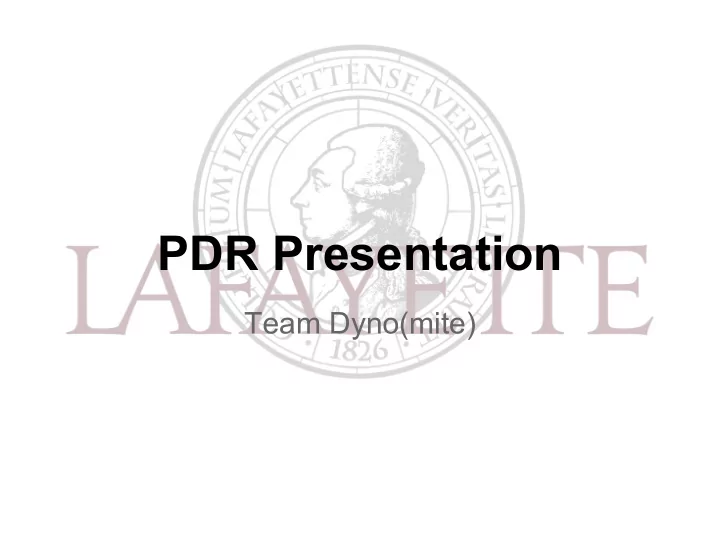

PDR Presentation Team Dyno(mite)
Acceptance Test Plan ● Sensors ○ 5 main metrics - Torque, speed, input voltage, output current, and system temperature ○ Will be tested by comparing results to manufacturers parameters ● Test Stand ○ Mostly physical design, including standards and safety measures ● Interfaces ○ Interfaces with every system ○ Testable assuming the respective system in complete ● Power Supply ○ Switchable sources with insulated connectors ● Safety ○ Safety loop fallback ○ Emergency stop button
ATP - Sensors ● Torque ○ Will be logged from the dynamometer ○ The basis for generating a torque curve ● Speed ○ Can be found in the motor encoder or controller frequency ○ Sources will be compared for redundancy ● Motor Current ○ Function of the motor controller for all three phases ● Controller Input Voltage ○ Function of the motor controller ○ Can be used to find the input current ● System Temperature ○ Measured at various points, including inside the controller
ATP - Test Stand ● Includes physical design considerations ○ checked by redundant inspection: ● Cable management ○ Based on the standards of GPR005 ● MCS cooling system ○ Must operate, but not necessarily well ● Physical design safety ○ Shielded connector covers ○ cable insulation
ATP - Interfaces ● Assumes that the other half of the interface is complete ● VSCADA ○ Data regarding the sensor systems must be delivered accurately ○ Verified by comparing to the locally logged data ● GLV Power ○ Sensor systems ○ VSCADA interface system ● TSV Load Controller ○ Alternative power source ● Safety Loop ○ The GLV safety loop must be able to shut the motor down
ATP - Power Supply ● The power supply must allow the motor to spin ○ Current draw figures will be collected ● Power supply switching ○ The power supply must be swappable without contacting uninsulated wiring
ATP - Safety ● Operational safety concerns should stop the motor ○ Ground Fault ○ Overtemperature ○ Overspin ○ Overtorque ● Emergency stop must be hardwired into the test stand ○ Disconnects the power supply from the motor controller
Subsystem Hierarchy
Requirements Matrix - Formula Hybrid Competition Rules ● List of all relevant rules and requirements that are set forth by the Formula Hybrid Competition ○ Motor Parameters ○ Motor Controllers ○ Sensors ○ Safety Concerns
Requirements Matrix - VSCADA ● Discusses the interactions between the Dyno system and the VSCADA team ○ Sensor integration ○ Motor Controller
Requirements Matrix - Motor, Controller, and Dynamometer Test Stand ● All requirements set forth in the Statement of Work in section R005 about the motor system ○ Equipment Necessary ○ Motor Parameters ○ Independent Safety Loop ○ Sensor Integration ○ Power Supply
Requirements Matrix - Safety Loop / TSV Load Controller ● Proper cables and cabling practices shall be used to ensure safety when the motor is operational and to power the system from the load controller
System State Analysis ● VSCADA will have primary state machine ● In general, the motor control system will have two main states ○ On ○ Off
System State Analysis - “On” State ● The system enters the “On” state when the driver turns the car on and the car is ready to drive ● Forward or reverse acceleration is possible in this state
System State Analysis - “Off” State ● Idle state ● Triggered by the driver turning the car off ● Can also be triggered by certain safety conditions ○ Overtemp ○ Overspin ○ Overtorque ○ Ground Fault ○ Emergency Stop Button
Cost Analysis Cabling - assuming 0 gauge wire Item Quantity Price Total 0 AWG (gage) wire - 50ft 1 $75.00 $75.00 Wire connector package 1 $50.00 $50.00 Temp sensor - DS18S20+CT- ND 5 $4.95 $24.75 Strain gage sensor - 1033- 1004-ND 1 $60.00 $60.00 optical encoder - 102-1923-ND 1 $20.00 $20.00 A2D converter 5 $4.00 $20.00 Total: $249.75
Risk Assessment ● Biggest risk - team member(s) falling behind schedule. ● Late delivery of dynamometer manual ● Late delivery of remaining sensors purchased with dynamometer ○ Strain gauge, optical encoder, special data cable for feedback information regarding valve in motor to control oil flow rate. ● Late deliverables from TSV group regarding battery pack - could impact accuracy of models. ● Late deliverables from GLV regarding safety loop could cause delays in integrating our safety loop with theirs to make a comprehensive system.
Work Breakdown Schedule ● Weekly Milestones ● Student Tasks ● Measurable and specific Week 2 Group � Finish PDR and Present Steve � Hierarchical Subsystem breakdown and semester task breakdown Alex � Complete ATP John � Risk Assessment and Cost Analysis Brendan � Requirement Analysis Nate � System State Diagram
Recommend
More recommend